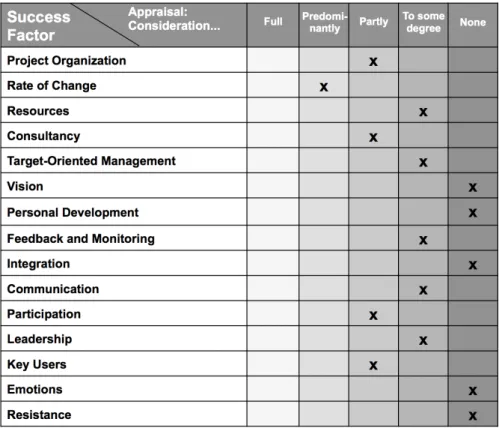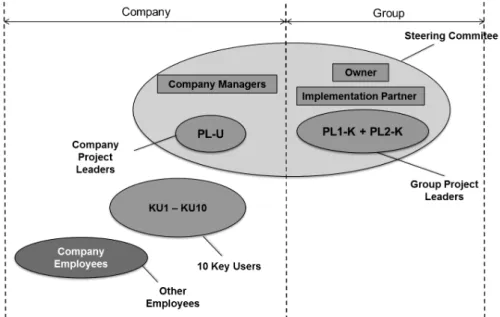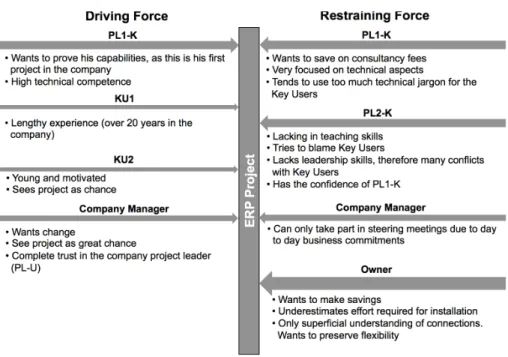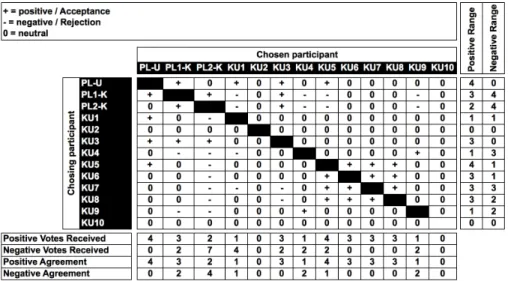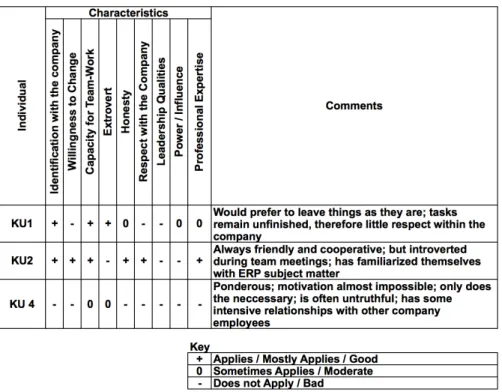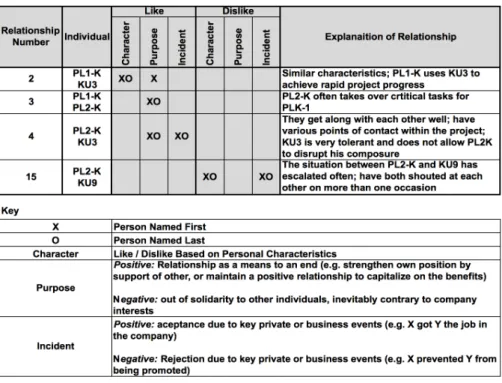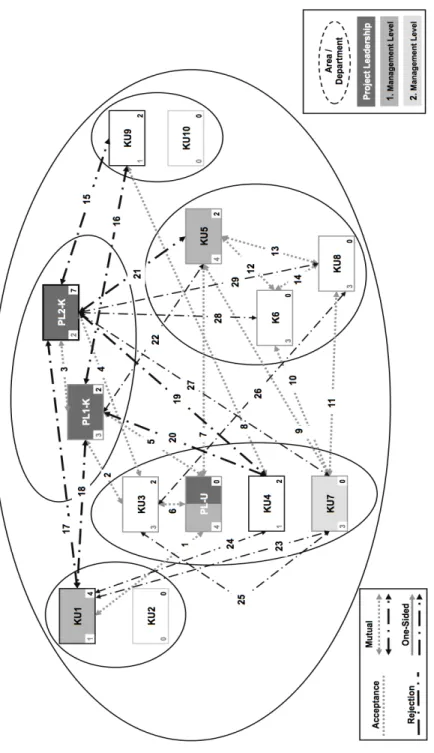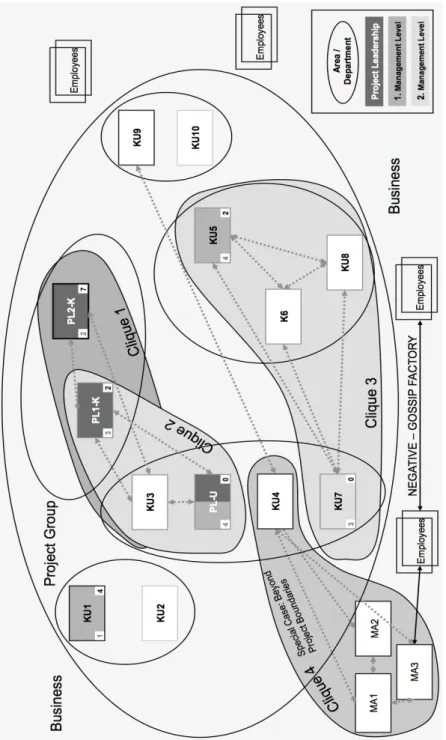INFORMAL STRUCTURES IN CHANGE PROJECTS – A HANDS-ON EXAMPLE
Mario Heiming Becker KG, Brakel, Germany
Wilfried Jungkind
Hochschule Ostwestfalen-Lippe, Lemgo, Germany
Abstract
Change management projects often involve a large amount of effort and only partial aim achievement. The main reason for this is that the personal character, motivation and behavior of the participants and their inter- personal relationships are often inadequately considered. Classic project management seldom includes these factors, due the current lack of published practical informal structural analysis methods. This paper will show how a checklist of “Success Factors in Change Management Projects”, as well as how selected informal structure analysis methods can be retrospectively applied to an Enterprise Resource Planning (ERP) project and what conclusions can be drawn for management success.
Keywords:
Project management, change projects, informal structures, management success
1. PROBLEM STATEMENT AND OBJECTIVES
The authors have often had the experience that change projects were difficult to carry out, even though a very good project management process, with accountability, defined activities, milestones and standards had been created, they did not fully achieve their objectives. The reason for this failure lay mostly with inter-personal relationships, the project participants’
individual characteristics, motivation and attitudes, were inadequately considered in project management. Besides the formal structure within an organization, an informal structure also exists. Generally, when confronted with resistance, project leaders and management attempt to apply and correct the visible formal structures. The crucial issues, however lie in an invisible, barely accessible gray zone, in the informal structures [1].
In order to ensure sustainable change project success it is, therefore, necessary to treat formal and informal structures as equally important.
These informal phenomena have been researched, but the results have not been included in practical project methods. It therefore comes as no
surprise that this subject, according to the author’s research, is hardly taken into consideration in classic project management.
This paper takes this as the starting point. The authors advance the theory that management success, in projects as well as in day-to-day operations, can be significantly increased if informal structures are taken into account.
The focus here is not on actively changing these structures, but to understand them and, with this understanding, to gain the participants’
commitment to the project.
The following will first show the basic parameters of a completed ERP project, in an SME where the author from the company was formerly employed as project leader, prior to his present position.
Initially, this project will be retrospectively assessed, according to general factors for success obtained from change project publications.
Subsequently, practical, publicized methods for analyzing inter-personal relations will be presented and retrospectively applied to the ERP project.
In conclusion, it will be shown that the initial theory can be proved and where further research is required.
2. ERP PROJECT
During 2011 and 2012, a new ERP system was introduced in the subject company. The manufacturing company belongs to a corporate group, which employs approximately 75 people and has a yearly turnover of approximately € 10 million.
From a corporate point of view, the implementation of a new ERP system was necessary due to the use of different software solutions in each company.
In a preliminary project, the most suitable software was chosen and was then to be rolled out in a pilot project at the subject company. During this process serious problems recurred, such as:
• Key user conflict of interests.
• Background propaganda and rumors in the company.
• Mood swings in the project team.
• Individual project team members’ excessive workload
• Repeated deviation from project plan, above all deadline postponement.
The ERP project could ultimately be implemented only with considerable effort.
3. SUCCESS FACTORS IN CHANGE PROJECTS
First of all, the typical change project success factors were identified and collated from relevant sources [2-12]. The ERP project was then evaluated according to these factors (Fig. 1).
Figure 1: Evaluation of the ERP project with the Checklist “Success Factors in Change Projects”.
A detailed description of the success factors in Fig. 1 is not possible in this paper; instead the main reasons for the rating given to some chosen factors will be discussed.
The project organization schedule produced was only assessed at irregular intervals; only rough milestones were in place, this resulted in late recognition of project delays.
In order to save on consultancy services, many of the system preference changes were undertaken in-house, in retrospect this lead to a greater need for correction.
Insufficient regard was given to the internal resources required, Key Users were not relieved of their every day duties, which often led to delayed and superficial project work.
Employees were not assessed as to whether they, as a result of a lack of experience, may require especially intensive training (personal development) before the system rollout.
Emotions were not examined or discussed in the project execution, which resulted in emotional outbursts due to changes of entrenched roles and responsibilities and new internal networks being formed.
Furthermore, which employee would offer resistance (oppositionists) was not considered.
The retrospective project assessment shows that the “soft” factors were predominantly responsible for the problems encountered.
The “success factors” illustrated do not take project members motives and their inter-personal relationships into account. This aspect of the ERP project should now be examined in more detail. The informal structures will therefore be analyzed, selected and applied to the ERP project.
4. COMPARISON AND SELECTION OF INFORMAL STRUCTURE ANALYSIS METHODS
Organizational achievement can almost exclusively be achieved by the group organizational form; individual performance is becoming less important. Therefore, knowledge of behavior within groups is gaining importance [13]. In order to select informal structure analysis methods, the authors have, based on their project experience, defined the following assessment criteria:
• Independence (the method is able to be applied without external consultancy/moderation).
• Effort (completion time is relatively short).
• Knowledge (important conclusions for change project optimization can be derived).
• Involvement (affected employees need not be involved in analysis)
• Knowledge/target situation (important conclusions for optimization/
target situation can be derived).
• Visualization (the constellations can be visually represented).
Twelve methods were found in publications, which could be analyzed according to the stated assessment criteria. The following five methods best fulfilled the criteria and were used for the ERP project:
• Force-field analysis.
• Sociomatrix.
• Sociogram.
• Clique analysis.
• Group as a Force.
5. APPLICATION OF SELECTED INFORMAL STRUCTURE ANALYSIS METHODS
Before the analysis results are presented, the ERP project structure must be explained briefly (see Fig. 2).
Two newly appointed project leaders were available to the company (PL1-K and PL2-K) who, together with the group project leader (PL-U), were to coordinate the pilot project. It would later be their job to lead the implementation projects in all the other companies within the group.
Additionally, there were 10 Key Users (KU) from all relevant areas of the company and a steering commitee for project control was formed.
Figure 2: ERP Project Organization.
5.1 Force-Field Analysis
Initially a force-field analysis was applied [cf. 14]. This serves to identify the driving and restraining forces, or the motivation behind the project, the arrow thickness represents the strength of influence.
Producing a Force-field analysis diagram is particularly helpful during the start phase of a project. The force-field analysis of the ERP project examined (Fig. 3) clearly shows that personnel can simultaneously be both driving (green arrows) and restraining (red arrows) forces.
The following conclusions can be made for the ERP project, for example:
• The owner exerts considerable pressure on the project behind the scenes.
• PL1-K possesses great technical knowledge, but cannot always get the other Key Users on board.
• PL2-K is not well liked and generates mistrust amongst the Key Users.
Figure 3: ERP Project Force-Field Analysis (detail).
5.2 Sociomatrix
A sociomatrix was also produced. In a sociomatrix the participants appraise each other, generally according to the criteria “positive” (acceptance /
respect) and “negative” (rejection / disrespect). Alternatively, the matrix can be created without involving the participants [15] as was done in the ERP project examined here (Fig. 4).
Figure 4: ERP Project Sociomatrix (complete).
A project leader or manager can, for example, once the project has reached a certain point, produce the matrix independently, as the participants have been observed over a long period of time. Sociomatrices can identify sociometric stars (a large number of positive votes), sociometric rejects (large number of negative votes), ghosts (vote, but receive hardly any positive votes) and isolates (don’t vote for other people and receive hardly any positive votes) [cf. 16].
5.3 Sociogram
The sociomatrix provides the basis of a sociogram, which serves to illustrate the relationship network as a diagram [cf. 17].
Before producing a sociogram, it is useful to assess the participants according to defined characteristics (Fig. 5). The characteristics chosen were considered to be relevant to the project situation.
In order to produce the ERP sociogram, every possible constellation between the project participants was assessed (see Fig. 6). A basic differentiation was made between like and dislike. The criteria Character, Purpose or Incident indicate the possible motivation behind the given assessment.
Figure 5: ERP Project Participant Characteristics (detail).
Using Figure 6 as a basis, a sociogram could be produced (Fig. 7).
The following conclusions could, for example, be drawn from the sociogram:
• Due to numerous conflicts, the respect for PL2-K sank within a very short period of time. Seven out of ten Key Users rejected this person due to their lack of leadership skills.
• KU-3 was the only Key User to be relieved of other duties, as a result of which, they had more intensive contact to PL1-K and PL2- K and were able to establish a personal relationship with them, but, at the same time, lost the respect of other colleagues.
• KU-4 and KU-9 were lacking in technical competence, which led to an increase in antipathy during the course of the project.
Figure 6: Assessment of Relations Between ERP Project Participants (detail).
5.4 Clique Analysis
Using the sociogram as a starting point, a clique analysis can be produced through the use of observation and meetings (Fig. 8). The aim of this method is to identify sub-groups (cliques). Cliques can be defined as a group of at least three people who are have a high degree of connection to one another. Cliques within a network can overlap, meaning a single person can belong to multiple cliques [cf. 18]. Fig. 8 shows the ERP clique analysis.
The results of the clique analysis can be interpreted as follows, for example:
• The constellation shown in the sociogram between PL1-K, PL2-K and KU-3 is identified as clique 1.
• KU-3 senses this, wants to maintain a good relationship to PL-U and makes a great effort to do so (clique 2).
• KU-5, KU-6, KU-7 and KU-8 have joined forces due to the generally problematic situation (Clique 3).
• Finally, KU-4, who has had serious conflict with PL1-K und PL2-K, is the source of a great deal of negative propaganda about the ERP project outside of the project group (Clique 4).
Due to space limitations, the results of the Group as a Force method shall be omitted.
6. CONCLUSION
This paper has described the retrospective application of the Checklist
“Success Factors in Change Projects” as well as the use of selected informal structure analysis methods. In the meantime, the authors have applied these “tools” to current projects. These projects have shown that, comparable to the ERP project illustrated, visual representations can quickly be produced and compared and that important conclusions can be drawn from these. In particular, the use of the checklist has greatly helped to reduce the personnel related problems in the course of current projects.
It is clear to the authors that the use of these methods by experts outside social science may present problems and that subjective influences can affect the results enormously.
It must be noted, however, after multiple application of these methods, that awareness of the importance of informal structures has greatly increased.
The main advantage of these methods can be seen in the structured way in which “instinct” can be visualized and that the extreme complexity of such social networks can be quickly ascertained. Therefore, principle fault lines and possible intervention approaches are quickly identifiable. Moreover, the use of various methods, such as force-field diagrams or sociomatrices, offers a broader view of the system as a whole.
The requirement of the scientific sector is that the available informal structure analysis methods be revised for day-to-day leadership practice and project management to enable technical engineers to apply them, since the authors experience has shown that this has led to a great improvement in management success.
Figure 7: ERP Project Sociogram (complete).
Figure 8: ERP Project Clique Analysis (complete).
REFERENCES
[1] Augustin, S.; von Hornstein, E.; Stihl, N. (2011): Change Management – Ein Wechselspiel von Psychologie und Logistik – Praxisgerechte Veränderungen durch Psychologistik. Gabler, Wiesbaden.
[2] Berger, M., Chalupsky, J., Hartmann, F. (2103) Change Management (Über-) Leben in Organisationen, Dr. Götz Schmidt, Gießen.
[3] Doppler, K., Fuhrmann, H., Lebbe-Waschke, B., Voigt, B. (2014) Unternehmenswandel gegen Widerstände – Change Management mit den Menschen, Campus, Frankfurt/M., p. 44.
[4] Doppler, K., Lauterberg, C. (2008) Change Management – Den Unternehmenswandel gestalten, Campus, Frankfurt/Main.
[5] Krüger, W. (2000) Excellence in Change – Wege zur strategischen Erneuerung, Gabler, Wiesbaden.
[6] Kotter, J. (2011) Leading Change – Wie Sie Ihr Unternehmen in acht Schritten erfolgreich verändern, Vahlen, München.
[7] Lauer, T. (2010) Change Management – Grundlagen und Erfolgsfaktoren, Springer, Heidelberg.
[8] Mollbach, A., Bergstein, J. (2011-2012) Change. Points of View. – Kienbaum Change-Management-Studie.
[9] Stolzenberg, K., Heberle, K. (2009) Change Management – Veränderungsprozesse erfolgreich gestalten – Mitarbeiter mobilisieren, Springer, Heidelberg.
[10] Vahs, D., Leiser, W. (2007) Change Management in schwierigen Zeiten – Erfolgsfaktoren und Handlungsempfehlungen für die Gestaltung von Veränderungsprozessen, GWV, Wiesbaden.
[11] von Rosenstiel, L., Nerdinger, F. (2011) Grundlagen der
Organisationspsychologie – Basiswissen und Anwendungs- hinweise, Schäffer-Pöschel, Stuttgart.
[12] Grimm, R., Krainz, E. (2011) Teams sind berechenbar –
Erfolgreiche Kommunikation durch Kenntnis der Beziehungsmuster, Gabler-Verlag, Wiesbaden, p. 48.
[13] Bräutigam, J. (1. Dezember 2009) Deutsche Universität für Verwaltungswissenschaften Speyer. Requestet at 9. april 2014 from http://www.dhv-speyer.de/HILL/Lehrangebot/Wintersemester-
2009/Selbstorganisiertes_Lernen/H%C3%B6rer-
Doks/Br%C3%A4utigam/S%20201%20Kraftfeldanalyse,%20Akteur sanalyse%20(Br%C3%A4utigam)5.pdf
[14] Wirtschaftslexikon24. Requestet at 12. April 2014 from
http://www.wirtschaftslexikon24.com/d/soziomatrix/soziomatrix.htm [15] von Ameln, F., Gerstmann, R.. Kramer, J. (2009) Psychodrama,
Springer-Verlag, Heidelberg, p. 247.
[16] Kretschmar, A. (1994) Angewandte Soziologie im Unternehmen, Gabler-Verlag, Wiesbaden, p. 43 f.
[17] Ricken, B., Seidl, D. (2010) Unsichtbare Netzwerke – Wie sich die soziale Netzwerkanalyse für Unternehmen nutzen lässt, Gabler- Verlag, Wiesbaden, p. 89.
